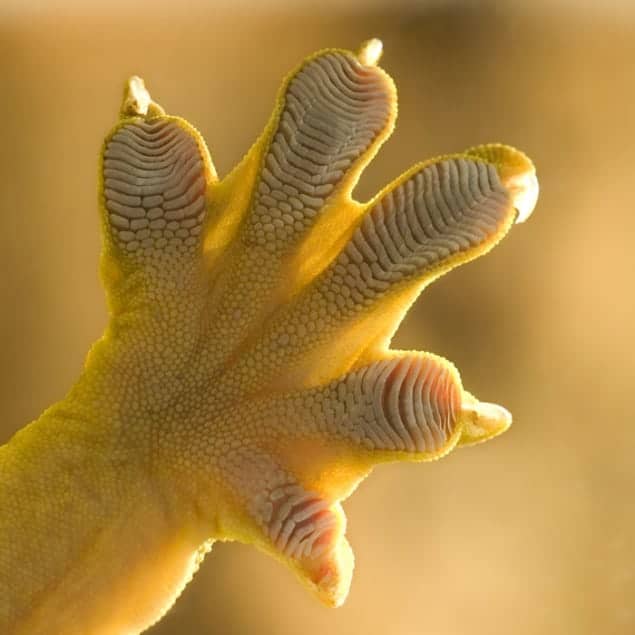
A material that promises to stick to smooth surfaces and then release on demand has been designed by scientists in the UK. The plasmonic metamaterial has yet to be built and tested in the lab, but if successful, it could be used to create artificial “gecko toes” that mimic those used by the lizards to walk up smooth walls.
The technique works by creating plasmons – quantized oscillations of electron density that occur in a conductor – by shining light on a conducting material. Creating plasmons causes regions of the conductor to become slightly positively charged and other regions to become negatively charged. If another surface is brought near enough to the material, there will be an attractive force drawing the two together. However, if the conductor is simply a flat sheet of metal film, then the resulting force is tiny and not very useful.
Plasmons also occur in artificial metamaterials, which are made of tiny structures with specific electromagnetic properties. Such metamaterials can be designed to resonate at certain plasmon frequencies, which allows the plasmons to hold much more energy.
Greater attraction
Nikolay Zheludev and colleagues at the University of Southampton suspected that the attractive force of such a plasmonic metamaterial would be much greater than a flat conductor, and have constructed a computer model to help test their ideas.
The team modelled a 2D plasmonic metamaterial comprising a thin film of evenly spaced gold structures that act as resonators. This is a common type of metamaterial that is simple to fabricate and has properties that are well understood. The researchers simulated the behaviour of the metamaterial when it is a few tens of nanometres from the surface of a conventional dielectric material. In particular, they looked at the forces that would result when the system is illuminated with light at or near the metamaterial’s resonant wavelength of 1370 nm.
If the light is fired from behind the metamaterial and then travels through it to the interface of the two surfaces, the simulation shows that the radiation pressure of the light would draw the two materials together. In other words, the two materials would feel a net attractive force. However, the strength of the attraction surprised the researchers – it is far stronger than can be explained by just radiation pressure pushing the metamaterial towards the other surface.
Trapped energy
“When you illuminate such a metamaterial structure with light, a lot of electromagnetic energy is trapped in the vicinity of the structure,” explains Zheludev. “We are talking about a distance that is less than the wavelength of light, so the density of trapped electromagnetic energy can become very high; and when you bring this structure close to the surface of something else, this trapped energy is affected by the presence of this other material. And in physics, a change in energy is always associated with a force.”
More interestingly, if the light first comes through the conventional dielectric material, the radiation pressure tends to push the metamaterial away. Nevertheless, the simulation predicts that, if the metamaterial were illuminated at or near its resonant frequency, the attraction caused by the optical adhesion force would be greater than the repulsion from the radiation pressure.
In either illumination scenario, the team calculates that the net force holding the metamaterial to the surface would be sufficient to overcome the downward pull of gravity on the metamaterial. As such, the metamaterial could in principle mimic a gecko’s toe – which can stick to a smooth surface when required and detaches on command to allow the lizard to take a step. This could be achieved with such a metamaterial by simply turning the light source on and off.
Remarkable study
“It is certainly an interesting and quite remarkable study,” says metamaterials expert Ortwin Hess of Imperial College London. “And I think it’s good to look into the very large opportunities that one has for structuring on the sub-wavelength scale – nanoscale in the case of visible light, or microscale in this case with infrared – and how these substructured materials can lead to completely new effects that are quite surprising.”
Before gecko-toe metamaterials can become useful, Zheludev says that we must find cheaper, more efficient ways to make plasmonic metamaterials on industrial scales. However, he is optimistic that such technical obstacles can be overcome with new innovations. In the short term, his team is working on achieving a “convincing demonstration and measurement of the effect in a laboratory system”.
A preprint about the research is available on arXiv.



